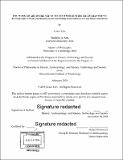| dc.contributor.advisor | Stefan Helmreich. | en_US |
| dc.contributor.author | Kim, Grace,Ph. D.Massachusetts Institute of Technology. | en_US |
| dc.contributor.other | Massachusetts Institute of Technology. Program in Science, Technology and Society. | en_US |
| dc.date.accessioned | 2019-10-11T21:53:03Z | |
| dc.date.available | 2019-10-11T21:53:03Z | |
| dc.date.copyright | 2019 | en_US |
| dc.date.issued | 2019 | en_US |
| dc.identifier.uri | https://hdl.handle.net/1721.1/122492 | |
| dc.description | Thesis: Ph. D. in History, Anthropology, and Science, Technology and Society (HASTS), Massachusetts Institute of Technology, Program in Science, Technology and Society, 2019 | en_US |
| dc.description | Cataloged from PDF version of thesis. | en_US |
| dc.description | Includes bibliographical references (pages 155-169). | en_US |
| dc.description.abstract | This ethnography tracks a diverse set of scientific practices that have developed new technologies for the conservation of artworks and cultural heritage. I examine how scientists in physics, chemistry, and biology have intervened in the restoration of artifacts ranging from faded abstract expressionist paintings to the crumbling clay terraces of an archaeological site. Reporting on archival research, interviews, and participant-observation, I juxtapose three case studies in the U.S. and Italy-two in which physics (Cambridge, MA) and chemistry (Florence) are conscripted into the realm of high modem art, and another in which biological knowledge (Milan) informs the preservation of artistic tradition and craft heritage. | en_US |
| dc.description.abstract | In analyzing interventions in digital projection technology (light), nanotechnology (colloids), and biotechnology (microbes), I argue that scientists today transform artifacts of culture into instances of technoscientific nature through what I call the "technoscientific re-enchantment of art." Aura, philosopher Walter Benjamin once wrote, is the ineffable and singular charisma that confirms an artwork as "the original." He added that technological reproducibility through film and photography strips art of its ritualistic authority, liberating it of the fetish of authenticity. To the contrary, I find, technology today is enlisted as a mode of authenticity's material production. Art's aura, in the age of technoscientific reenchantment, does not disappear but rather, is re-valued through analogy-analogies made through the discursive and material practices that liken light to paint, the colloidal substance of the human body to that of artworks, and microbes to patina. | en_US |
| dc.description.abstract | Laboratory scientists, I show, are recasting the materials of art and heritage to make the terms of their recovery amenable to technoscientific mediation. In so doing, scientists contribute to enduring ethical debates within art history and heritage preservation-debates about how to interpret an artist's intent and an object's pristineness or historicity. Finally, I explore a fourth field site, the Vatican Museums, as a framing device for understanding the stakes in contemporary conservation practice. Drawing on the anthropology of art and heritage, science and technology studies, and art history, I explore the multiple, ever-changing claims of technoscientific expertise over matters of the materiality, aesthetics, and history of artifacts. | en_US |
| dc.description.statementofresponsibility | Grace Kim. | en_US |
| dc.format.extent | 169 pages | en_US |
| dc.language.iso | eng | en_US |
| dc.publisher | Massachusetts Institute of Technology | en_US |
| dc.rights | MIT theses are protected by copyright. They may be viewed, downloaded, or printed from this source but further reproduction or distribution in any format is prohibited without written permission. | en_US |
| dc.rights.uri | http://dspace.mit.edu/handle/1721.1/7582 | en_US |
| dc.subject | Program in Science, Technology and Society. | en_US |
| dc.title | The work of art in the age of its technoscientific re-enhancement : recasting light, Colloids, and microbes for art and heritage conservation in U.S. and Italian laboratories | en_US |
| dc.type | Thesis | en_US |
| dc.description.degree | Ph. D. in History, Anthropology, and Science, Technology and Society (HASTS) | en_US |
| dc.contributor.department | Massachusetts Institute of Technology. Program in Science, Technology and Society | en_US |
| dc.identifier.oclc | 1121081271 | en_US |
| dc.description.collection | Ph.D.inHistory,Anthropology,andScience,TechnologyandSociety(HASTS) Massachusetts Institute of Technology, Program in Science, Technology and Society | en_US |
| dspace.imported | 2019-10-11T21:53:02Z | en_US |
| mit.thesis.degree | Doctoral | en_US |
| mit.thesis.department | STS | en_US |
